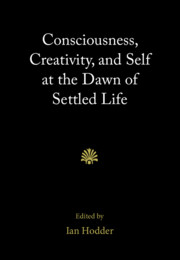Book contents
- Consciousness, Creativity, and Self at the Dawn of Settled Life
- Consciousness, Creativity, and Self at the Dawn of Settled Life
- Copyright page
- Contents
- Contributors
- Acknowledgments
- Part I Introduction to the Themes, Site, and Region
- Part II Higher Levels of Consciousness
- Part III Greater Innovation and Creativity
- Part IV Greater Awareness of an Integrated Personal Self
- 10 Personal Memory, the Scaffolded Mind, and Cognitive Change in the Neolithic
- 11 Adorning the Self
- 12 From Parts to a Whole? Exploring Changes in Funerary Practices at Çatalhöyük
- 13 New Bodies: From Houses to Humans at Çatalhöyük
- Notes
- Index
- References
12 - From Parts to a Whole? Exploring Changes in Funerary Practices at Çatalhöyük
from Part IV - Greater Awareness of an Integrated Personal Self
Published online by Cambridge University Press: 22 February 2020
- Consciousness, Creativity, and Self at the Dawn of Settled Life
- Consciousness, Creativity, and Self at the Dawn of Settled Life
- Copyright page
- Contents
- Contributors
- Acknowledgments
- Part I Introduction to the Themes, Site, and Region
- Part II Higher Levels of Consciousness
- Part III Greater Innovation and Creativity
- Part IV Greater Awareness of an Integrated Personal Self
- 10 Personal Memory, the Scaffolded Mind, and Cognitive Change in the Neolithic
- 11 Adorning the Self
- 12 From Parts to a Whole? Exploring Changes in Funerary Practices at Çatalhöyük
- 13 New Bodies: From Houses to Humans at Çatalhöyük
- Notes
- Index
- References
Summary
Death is a universal and profoundly emotive human experience with social and economic implications that extend to communities as a whole. As such, the act of disposing of the dead is typically laden with deep meaning and significance. Archaeological investigations of funerary practices are thus important sources of information on the social contexts and worldviews of ancient societies. Changes in funerary practices are often thought to reflect organisational or cosmological transformations within a society (Carr 1995; Robb 2013). The focus of this volume is the role of cognition and consciousness in the accelerated sociocultural developments of the Neolithic Period in the Near East. In the introduction to this volume, Hodder identifies three commonly cited cognitive changes that can be measured against various archaeological datasets from Çatalhöyük. The funerary remains at Çatalhöyük are an obvious source of data for validating Hodder’s third measure of change: a shift from a fluid and fragmented conception of the body and of selfhood to a greater awareness of an integrated, bounded personal self.
- Type
- Chapter
- Information
- Consciousness, Creativity, and Self at the Dawn of Settled Life , pp. 250 - 272Publisher: Cambridge University PressPrint publication year: 2020
References
- 2
- Cited by



